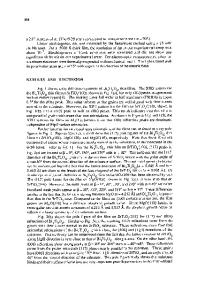Enhanced Electrical properties in Mn-doped Bi 3.25 La 0.75 Ti 3 O 12 thin films
- PDF / 1,986,883 Bytes
- 6 Pages / 612 x 792 pts (letter) Page_size
- 28 Downloads / 354 Views
0902-T03-52.1
Enhanced Electrical properties in Mn-doped Bi3.25La0.75Ti3O12 thin films S. K. Singh and H. Ishiwara Interdisciplinary Graduate School of Science and Engineering Tokyo Institute of Technology, 4259 Nagatsuda, Midori-ku, Yokohama 226-8503, Japan
Abstract Mn-doped Bi3.25La0.75Ti3O12 (BLT) thin films were fabricated by depositing sol-gel solutions on Pt/Ti/SiO2/Si substrates. The surface morphology and ferroelectric properties of Mn-doped BLT films depend upon the orientation of the films. Small amount of Mn-doping in BLT films influences the ferroelectric properties of the films, that is, it enhances the remanent polarization and reduces the coercive field. The 1% Mn-doped BLT films show enhanced remanent polarization and reduced the coercive field by about 22%. To the contrary, Mn-doping more than 1% decreases polarization gradually. Mn-doping significantly improves the fatigue resistance of BLT films. The reduced polarization in the 3.3% Mn-doped thin film recovers during switching cycles higher than 5 x 105. Under high switching field, the probability of field-assisted unpinning of domains is expected to be high and this may be the main cause for increase in polarization after 5 x 105 in the 3.3% Mn-doped BLT film. Keywords: Ferroelectric thin film, Chemical solution deposition, Site engineering, Electrical properties.
Introduction: Bismuth layered perovskite compounds such as SrBi2Ta2O9 (SBT) and La-substituted Bi4Ti3O12 (BTO) are considered to be candidates for memory applications, such as non-volatile ferroelectric random access memory (NvFeRAM), because of their high fatigue endurance limit and lead-free chemical composition compared with simple perovskite Pb(Zr1-xTix)O3 (PZT) [1-2]. SBT (n=2) and BTO (n=3) belong to the class of Aurivillius phases with layered intergrowth structures, which consist of “n” layers of perovskite-like blocks sandwiched between two consecutive fluorite-like (Bi2O2) layers. Bi4-xLaxTi3O12 (BLT) is a more promising candidate for NvFeRAM than SBT because SBT films require high growth temperature and they show small remanent polarization compared to BLT [3]. From considerations of the structural chemistry of the Aurivillius phases, site-engineering (substitution technique) is an important factor to improve the properties of the materials [4]. The influence of the Bi3+ site substitution by isovalent La3+, Nd3+, Pr3+, Sm3+ cations and Ti4+ site substitution by higher valent V5+, W6+, Mo6+ cations on the ferroelectric properties of BTO have been reported in the literature [4-9]. It has been shown that the Bi–site substitution can increase the polarization as well as coercive field. However, in case of Ti-site substitution, the polarization may increase whereas the coercive field may decrease. Ti-site substitution by higher valent cations is functional to the decrease in oxygen vacancy, but at the same time, these cations have alterable valence like Ti4+, which can induce additional space charges, and thereby reduce the fatigue resistance [10]. Substitution of Ti4+ with the
Data Loading...










